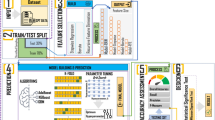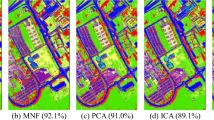Abstract
Band selection is an effective means to reduce the hyperspectral data size and to overcome the Hughes phenomenon in ground object classification. This paper presents a band selection method based on particle swarm dynamic with sub-swarms optimization, aiming at the deficiency of particle swarm optimization algorithm being easy to fall into local optimum when applied to hyperspectral image band selection. This algorithm treats fitness function as criterion, dividing all particles into different adaptation degree interval corresponding to the dynamic subgroup and adopting different optimization methods for different subgroups as well as sub -swarms parallel iterative searching for the optimal band. In this way, we can make achievement of clustering optimization of particle with different optimization capability, ensuring the diversity of particles in order to reduce the risk of falling into local optimum. Finally, we prove the effectiveness of this algorithm through selected bands validation by support vector machine.





Similar content being viewed by others
References
Zhong, Z., Fan, B., Duan, J., Wang, L., Ding, K., Xiang, S., et al. (2017). Discriminant tensor spectral–spatial feature extraction for hyperspectral image classification. IEEE Geoscience and Remote Sensing Letters, 12(5), 1028–1032.
Gao, J., Xu, L., & Huang, F. (2016). A spectral–textural kernel-based classification method of remotely sensed images. Neural Computing and Applications, 27(2), 431–446.
Sheng, D., & Yuan, X. (2010). Automatic band selection of hyperspectral remote sensing image classification using particle swarm optimization. Acta Geodaetica Et Cartographica Sinica, 39(3), 257–263.
Xu, M., Xu, F., & Huang, C. (2011). Image restoration using majorization-minimizaiton algorithm based on generalized total variation. Journal of Image & Graphics, 16(7), 1317–1325.
Kang, X., Li, S., & Benediktsson, J. A. (2014). Feature extraction of hyperspectral images with image fusion and recursive filtering. IEEE Transactions on Geoscience and Remote Sensing, 52(6), 3742–3752.
Kuo, B. C., Ho, H. H., Li, C. H., Hung, C. C., & Taur, J. S. (2013). A kernel-based feature selection method for svm with rbf kernel for hyperspectral image classification. IEEE Journal of Selected Topics in Applied Earth Observations & Remote Sensing, 7(1), 317–326.
Feng, J., Jiao, L. C., Zhang, X., & Sun, T. (2014). Hyperspectral band selection based on trivariate mutual information and clonal selection. IEEE Transactions on Geoscience and Remote Sensing, 52(7), 4092–4105.
Chen, Z., Wang, X., Sun, Z., & Wang, Z. (2016). Motion saliency detection using a temporal fourier transform. Optics & Laser Technology, 80, 1–15.
Gurram, P., & Kwon, H. (2014). Coalition game theory based feature subset selection for hyperspectral image classification. Igarss IEEE International Geoscience & Remote Sensing Symposium (pp. 3446–3449). IEEE.
Qiu, M., & Sha, H. M. (2009). Cost minimization while satisfying hard/soft timing constraints for heterogeneous embedded systems. ACM Transactions on Design Automation of Electronic Systems, 14(2), 1–30.
Li, S., Wu, H., Wan, D., & Zhu, J. (2011). An effective feature selection method for hyperspectral image classification based on genetic algorithm and support vector machine. Knowledge-Based Systems, 24(1), 40–48.
Qiu, M., Zhong, M., Li, J., Gai, K., & Zong, Z. (2015). Phase-change memory optimization for green cloud with genetic algorithm. IEEE Transactions on Computers, 64(12), 3528–3540.
Qiu, M., Chen, Z., Niu, J., Zong, Z., Quan, G., Qin, X., et al. (2015). Data allocation for hybrid memory with genetic algorithm. IEEE Transactions on Emerging Topics in Computing, 3(4), 544–555.
Li Y. J., Liang K., Tang X. J., & Gai K. K. (2017). Waveband Selection Based Feature Extraction Using Genetic Algorithm. 2017 I.E. 4th International Conference on Cyber Security and Cloud Computing (CSCloud), pp. 223–227.
Du, Q., Gao, L., & Zhang, B. (2014). Ant colony optimization-based supervised and unsupervised band selections for hyperspectral urban data classification. Journal of Applied Remote Sensing, 8(1), 085094.
Chang, Y. L., & Huang, B. (2014). Hyperspectral band selection based on parallel particle swarm optimization and impurity function band prioritization schemes. Journal of the Electrochemical Society, 8(1), 084798.
Li, J., & Ding S. (2012). Spectral feature selection with particle swarm optimization for hyperspectral classification. 2012 International Conference on Industrial Control and Electronics Engineering, pp. 414–418.
Su, H. J., Du, Q., Chen, G. S., & Du, P. J. (2014). Optimized hyperspectral band selection using particle swarm optimization. IEEE Journal of Selected Topics in Applied Earth Observations and Remote Sensing, 7(6), 2659–2670.
Zhang, M. Y., Ma, J. J., & Gong, M. G. (2017). Unsupervised hyperspectral band selection by fuzzy clustering with particle swarm optimization. IEEE Geoscience and Remote Sensing Letters, 14(5), 773–777.
Zheng, K. W., & Wang, H. F. (2014). A dynamic local and global conjoint particle swarm optimization algorithm. International Journal of Information and Management Sciences, 25(1), 1–16.
Han, J. H., Li, Z. R., & Wei, Z. C. (2006). Adaptive particle swarm optimization algorithm and simulation. Journal of System Simulation, 18(10), 2969–2971.
Chen, Y. P., & Jiang, P. (2010). Analysis of particle interaction in particle swarm optimization. Theoretical Computer Science, 411(21), 2101–2115.
Xu, F., Fan, T., Huang, C., Wang, X., & Xu, L. (2014). Block-based map superresolution using feature-driven prior model. Mathematical Problems in Engineering, 2014(7), 1–14.
Vapnik, V. N. (1995). The Nature of Statistical Learning Theory. Berlin: Springer.
Acknowledgements
This paper is supported by National Natural Science Foundation of China (No. 61603124, No. 61701166), sponsored by Qing Lan Project, and the Natural Science Foundation of Jiangsu Higher Education Institutions of China (No. 17KJB520010).
Author information
Authors and Affiliations
Corresponding author
Rights and permissions
About this article
Cite this article
Xu, M., Shi, J., Chen, W. et al. A Band Selection Method for Hyperspectral Image Based on Particle Swarm Optimization Algorithm with Dynamic Sub-Swarms. J Sign Process Syst 90, 1269–1279 (2018). https://doi.org/10.1007/s11265-018-1348-9
Received:
Revised:
Accepted:
Published:
Issue Date:
DOI: https://doi.org/10.1007/s11265-018-1348-9




